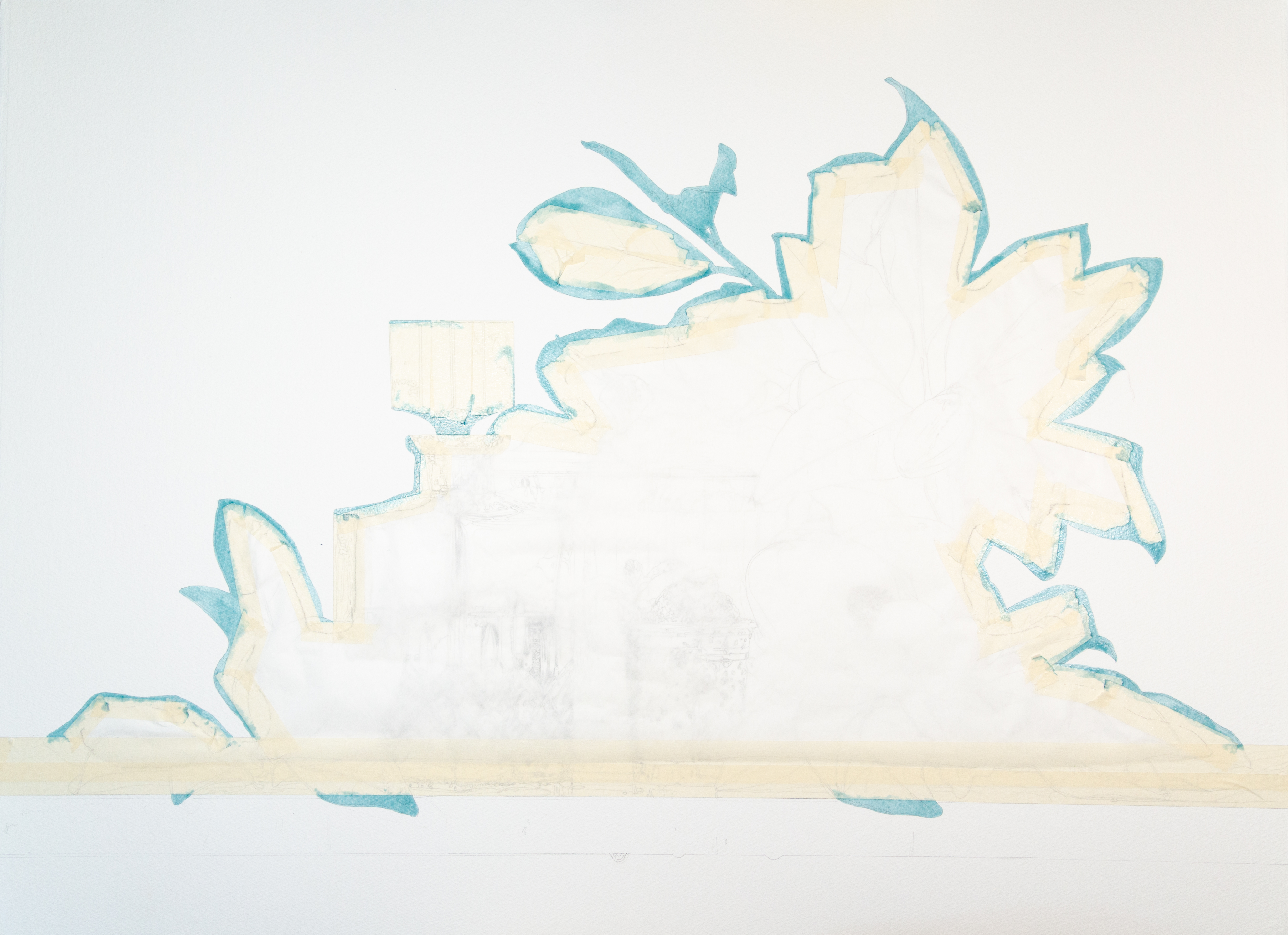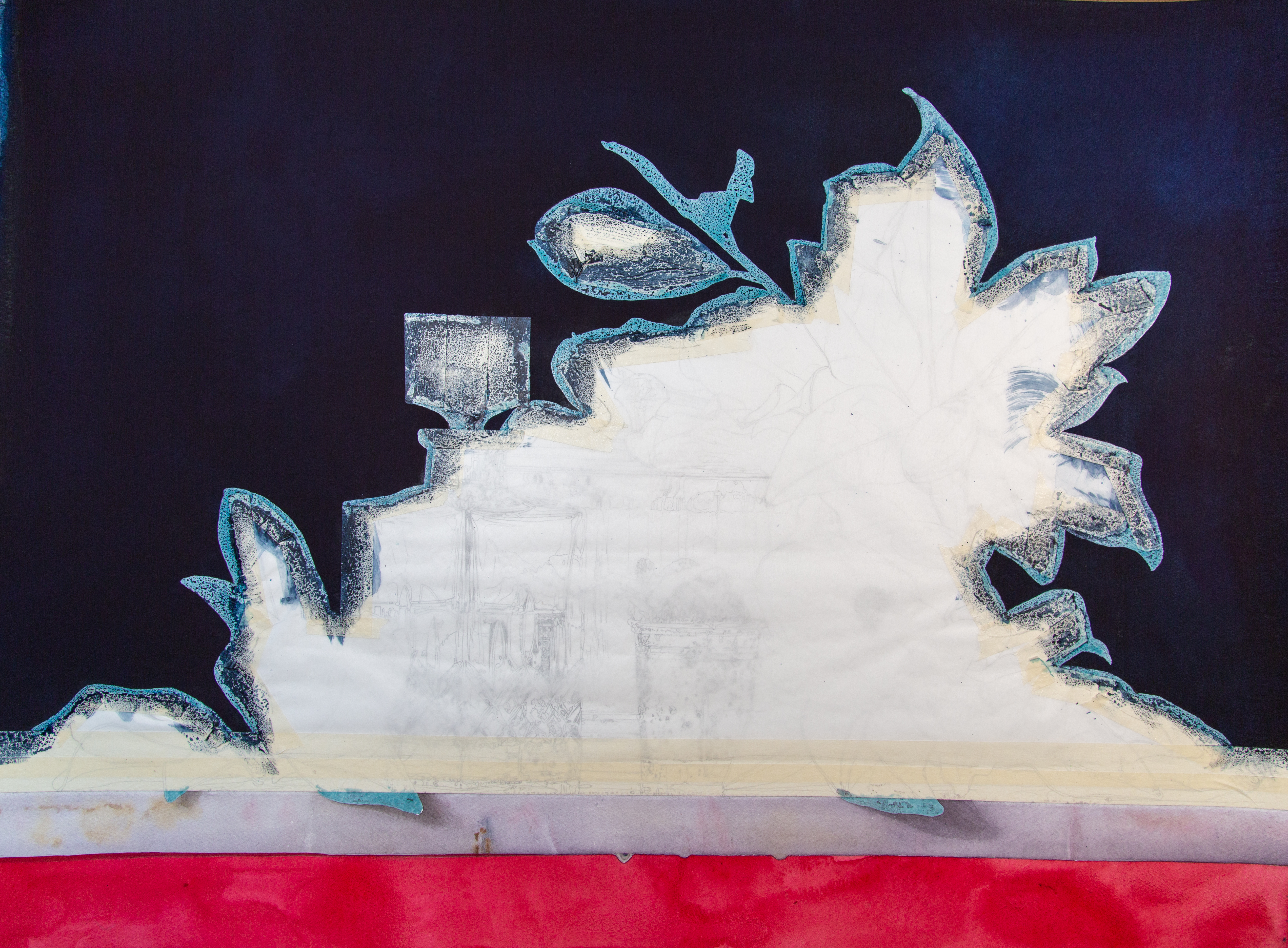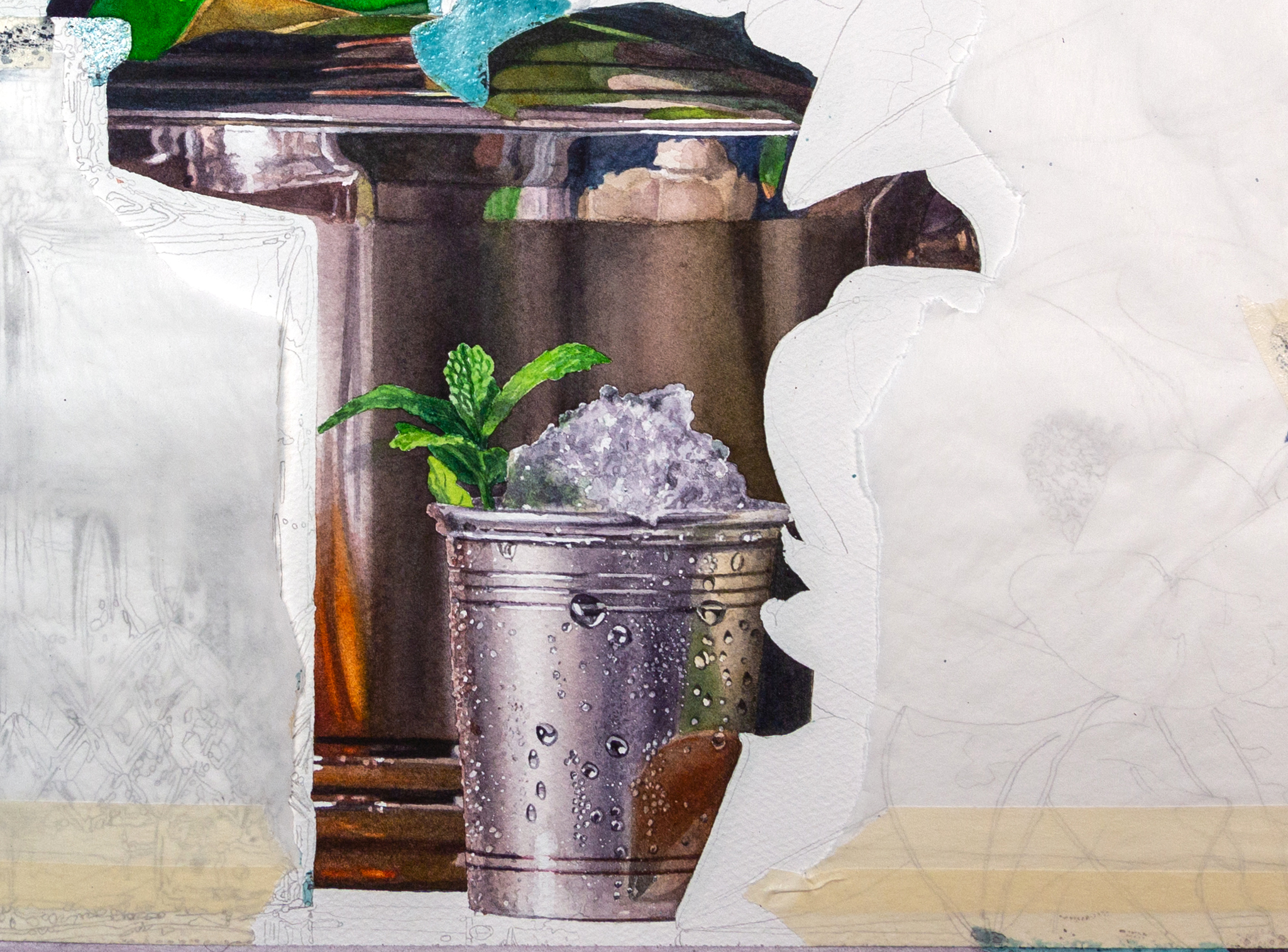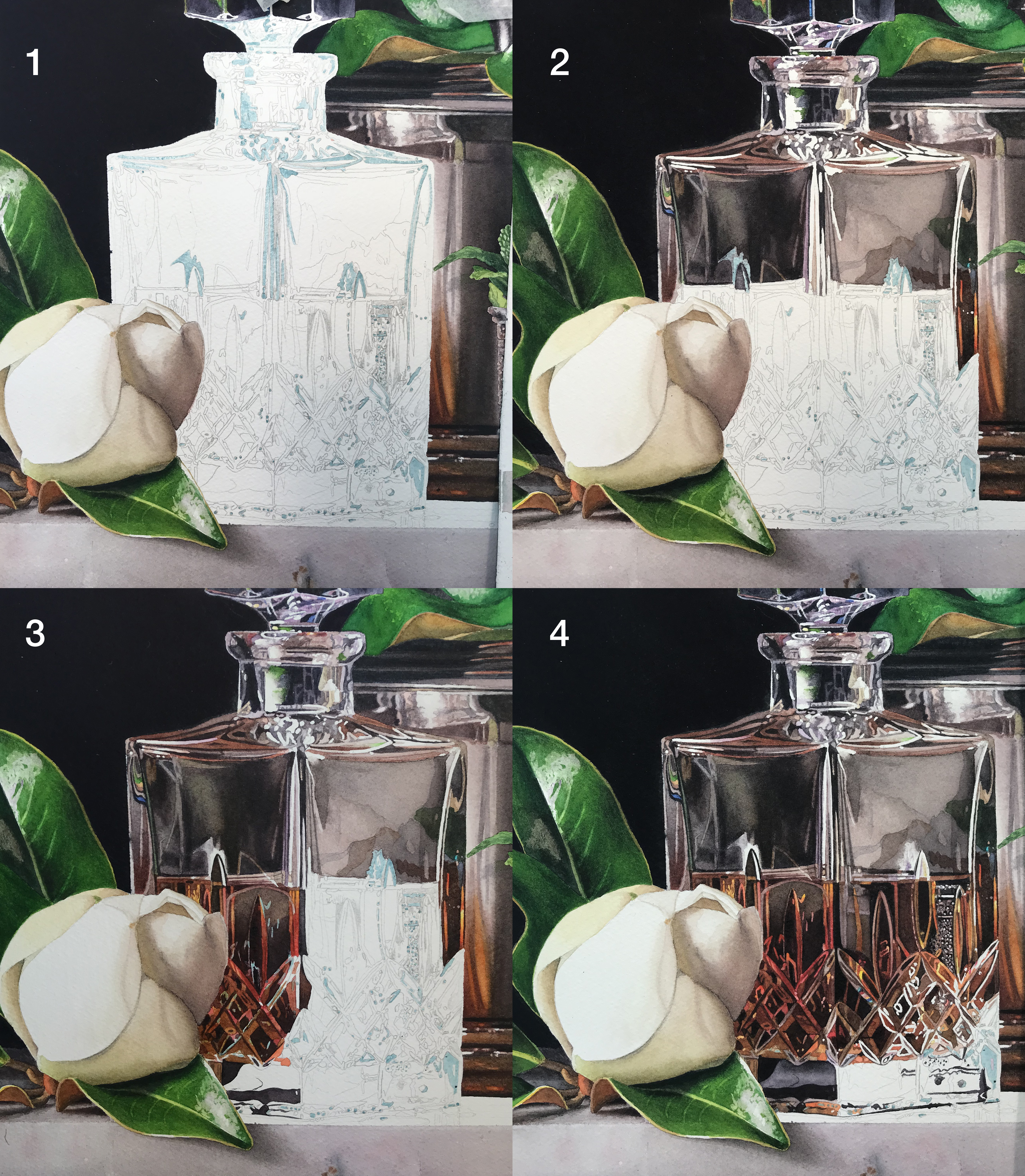BY MATTHEW BIRD

One aspect of still life painting that I enjoy most is exploring textures I don’t encounter in my figurative work. In the case of Magnolia Still Life, I was interested in the condensation that formed on the silver cup, not just because it perfectly captures the quenching ability of an icy mint julep, but because it was a new texture for me, and one that I would use to build the entire painting.
Painting with transparent watercolor means there is no white or opaque paint. Any whites in the final painting are the white of the paper, carefully preserved with tracing paper, tape, or masking fluid. The first step is a very detailed drawing, which serves as a road map. For this painting, when the drawing was complete, I masked everything so I could establish the setting of a very dark background and marble table.

For the backdrop, I made an underpainting of Prussian blue, plus 4 to 5 layers of a custom black mix (mineral violet, Prussian blue, and permanent alizarin crimson). After each layer completely dried, I rewet the paper with a large Hake brush and added more of the dark paint, wet-into-wet, while allowing a little of the blue underpainting to show through in the upper right corner for contrast.
The wooden table beneath the marble top was in deep shadow and mostly black, but it needed to be a different black than the background. A warm underpainting of permanent alizarin crimson helped achieved this.

Tackle the Difficult Things First
As a loose rule, I try to tackle the most difficult elements first, so if I mess up I won’t have too much time invested. In this case, it was the frosty julep cup — something I had never painted before. I cut an opening in the tracing paper where I would work. The rest of the painting remained covered to protect those areas from splatters and spills. The condensation on the cup, mint leaves, and ice mound were all preserved with masking fluid.

I painted the frosted silver wet-into-wet, through multiple layers until the values were correct. The colors were from the “slop” in the middle of my palette— various warm and cool greys. Next, I removed the masking and painted each water droplet wet-on-dry, so the edges are crisp and well defined.

Painting Leaves
Next, I turned to the magnolia leaves and flowers, working back to front. The first step for each leaf was carefully masking the veins (1), then adding an underpainting of Payne’s gray to establish form and value (2). I then applied layers of green and light red. Once this was completely dry, I removed the mask (3). These leaves are in shadow and need to be much darker, so I used additional layers of color to push them back (4).

How I Approach Crystal
Finally, the pièce de résistance: the crystal decanter. Crystal is challenging to paint for a number of reasons. Like any glass object, it’s translucent so you see what is behind, and also reflective of the things around it. But crystal also refracts the light like a prism, creating interesting colors and patterns.
Before painting, it’s important to study and understand what you are actually seeing, not what you think it should be. I’ve painted crystal many times and didn’t think this would be much different, but I failed to notice that the julep cup, with all its water droplets, was reflected in the glass. This added another layer of complexity, and had I fully appreciated this at the start, I probably would not have done this last.
I make light notations with a hard pencil to help me organize the shapes and understand the surface. Again, I save the whites with masking fluid, and shade the darkest areas with pencil. I find it helpful to have to extreme ends of the value scale established, and then work in between (1). I paint from the top down, working wet-into-wet for the smooth areas of glass that require subtle transitions (2), and wet-on-dry for the hard edges (3,4).

Final Tweaks
I like to let the painting sit for a few days, and come back to it with fresh eyes. I continually make tweaks, usually to darken values, and find little things I missed along the way.
Materials List
Paper: 300-lb. Fabriano Artistico Extra White cold-pressed
Brushes: 2- or 3-inch Hake Brush; Escoda small, medium, and large rounds; and an old, stiff synthetic brush for blending and lifting.
Artists’ Quality Watercolors (mostly by Daniel Smith):
Cadmium yellow medium
Light red (Winsor & Newton)
Mineral violet (Holbein)
Permanent alizarin crimson
Prussian blue
Hooker’s green
Quinacridone burnt orange
Quinacridone burnt scarlet
Burnt sienna
Raw umber
Burnt umber
Payne’s gray
Misc.: Masking Tape and fluid; and lightweight tracing paper
In Laurin McCracken’s “Watercolor Realism — Silver & Crystal”, you’ll discover insights and strategies to improve your photorealism even further, turning your art into a masterpiece that transfixes art lovers.








Incredible paintings and wonderful explanation and photo examples. Thank you so much, Matthew Bird!
I would like to thank Master Matthew for sharing his techniques. It’s precisely what I am interested in when painting in this medium. In fact, a big shout out goes to all the masters who teach and share their excellence! You all perpetuat the medium, this style and launch interested artists like me light years ahead in our own studies and endeavors
Matthew is a master watercolor artist who impresses me with each painting that he creates. Seeing the step by step process is so informational. Although I am not inspired to paint this photorealistically, I admire those who do. Continue to watch this artist, and collect his work, you will see his work increase in value as he ‘ages’. Bravo!
Thanks a lot for sharing these tecniques….
Just Beautiful and makes me want to work harder and to stay green and growing always.
Amazing work. The amount of patience and the attention to detail, along with the clear understanding of light, shape, colour and composition, are fantastic.
Thank you for sharing your amazing paintings and techniques. I’m excited that I’ll be able to see your work at the Salmagundi Club in April. I’m traveling with the Baltimore Watercolor Society to see the exhibit on the 15th.
Paintings by Matthew Bird are absolutely the best EVER. Thank you for letting us view these.
Fantastic article. Very inspirational to me.
So very impressive and so inspirational. I loved the article and his explanation, beautiful paintings.